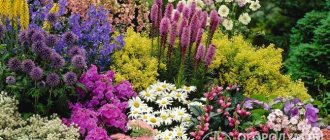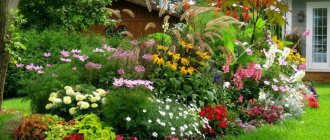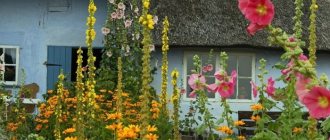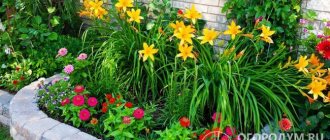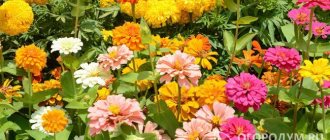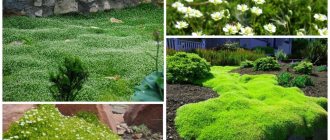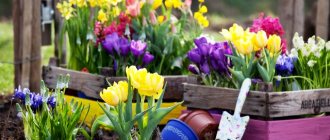Plain flower garden
You can use flowers of only one color or similar shades. To choose the right color scheme for plants, you can use a color wheel.
The color wheel will help you build a monochrome flower bed correctly
To build a monochromatic flower garden, you need to take two colors that are close in the color circle or take one color and, based on its shades, choose plants.
Monochrome flower bed options:
| Option 1. In landscape style White flower planting scheme:
Flowering in this flowerbed will occur continuously | |
| Option 2. Pink-red flowerbed A bright and continuously blooming flowerbed:
|
Annual long-blooming flowers
If you like annual changes in the arrangement of your flowering beds, you should choose annual or biennial plants. They have the added benefit of preventing pathogens from overwintering on the plants as they are usually removed from the garden before winter sets in.
Unfortunately, annual flowers require more work during their first growing season than perennials because they need to be replanted every year, watered regularly, and weeded until they become established. Sensitive species planted too early may be damaged by spring frosts. However, with modern planting and proper care, they provide many options for garden decoration.
Most garden perennials delight with the beauty of their flowers only for a short time. In the remaining days, they attract attention due to the shape and color of the leaves, the shape of the plant, the seeds, and the autumn color of the leaf. Fortunately, in the plant world there are perennial garden flowers that acquire new inflorescences over many weeks or even months. Let's consider low-growing species of both annual and perennial flowers.
Marigold
This flower has tall varieties, reaching about 1 meter, and rather small, low-growing varieties for flowerbeds, growing to about 20-30 cm.
Marigolds have a number of advantages:
- durable;
- have no special soil requirements;
- tolerate heat;
- resistant to water shortages;
- tolerate spring cold.
The main enemy of marigolds is aphids.
These low-growing annual flowers bloom from late spring until autumn - until the first frost. The inflorescences come in different colors: yellow, orange, brown-orange or cream. Plants love sunny positions.
Begonia
Begonia is a small shrub plant reaching a height of 20-30 cm, although taller varieties exist. Like marigolds, begonias bear flowers from May until frost. These annual flowers love acidic soils and sunny positions.
Pros of begonia:
- not particularly susceptible to pests;
- do not suffer from temporary drought.
Flowers are found in colors: white, pink, red, some varieties additionally have a burgundy tint of leaves.
Sage sparkling
This is a bush up to 20-40 centimeters high, with erect, stiff shoots and prickly, intense red flowers. Different varieties have flowers that are white, cream, or purple. Sage can grow in different soils, but prefers fertile, humus, moist soil. The plant loves sunny positions. It blooms for a long time, like the previous 2 species - from spring to late autumn.
Zinnia graceful
Zinnia reaches a height of 1 meter, although there are dwarf plants 30 cm high. Zinnia loves warm, sunny, fairly humid places, humus soils. Blooms from June until frost. Many varieties of this beautiful plant are known, differing mainly in the number and color of flowers: white, yellow, orange, shades of red.
Verbena hybrid
It is a small shrub, growing up to 20-40 centimeters in height, with thin feathery leaves and flowers collected in umbels.
The advantage of verbena: it is resistant to spring temperature changes.
Requirements:
- solar position;
- fertile, moist soil.
Verbenas are sensitive to drought. Plants are sometimes attacked by spider mites and aphids. They bloom from June until the first frost, with flowers of white, pink, red, and purple colors. Cultivars may have multi-colored petals (for example, with a white stripe through the center).
Stemless thornweed
This is a biennial plant from the Asteraceae family, native to the alpine regions of southern and central Europe. The above-ground part of the plant in the form of a rosette reaches 20-15 cm in diameter. The plant is characterized by a very shortened stem or its absence. The leaves are pinnate and spiny. Thornberry blooms from July to September. Luxurious silver-white flower baskets with a diameter of 7-15 cm appear at the top of the rosette. The inflorescence opens only in the sun and closes when exposed to high humidity. The plant is used for planting in rock gardens and for dry bouquets.
Thyme leaf gerbil (arenaria)
Chickweed (Arenaria serpyllifolia L.) is a species of the carnation family. The plant is distributed throughout the world. Natural habitat is Asia, Europe and North Africa. The leaves of the plant are pointed. White flowers bloom on the stems, in the axils of the upper leaves. The stem is spreading, highly branched, 5-20 cm high. The fruit is an egg-shaped capsule with weak teeth.
Arenaria is an annual or biennial, spring or winter plant. Blooms from May to October. This is a cereal weed. It is found on sandy, humus, and limestone soils.
Variegated flowerbed
The main thing for a bright flower bed is a harmonious combination of plants and flower compatibility.
Plant compatibility is an important point in choosing flowers. For example,
- peonies do not get along with roses, so it is better not to plant them in the same flower bed;
- lilies of the valley will not bloom next to peonies;
- and next to the roses, carnations and mignonette will wither.
Flower planting schemes for a variegated flower bed:
| Option 1 The diagram shows planting flowers for a mixed flower bed of plants of different sizes:
| |
| Option 2 Planting scheme for a flower bed of perennials: Tall perennials.
The following plants were used as accompanying plants:
Of the ground cover perennials, primarily along the edges of the flower bed, the following are planted:
Tall and ground-cover perennials are involved in the creation of such a flower garden; accompanying plants are presented under numbers - 4–8 |
Low growing ornamental plants
Flowers that reach a height of no more than 30 cm are considered to be low-growing. Magnificent front gardens can be formed either with the help of one type of similar flowers for a flower bed that blooms all summer, or with an extensive combination of them.
Stepped structures made from such plants, framed by low-growing flowers of a contrasting shade, look especially nice. Decorative borders limited to compact bushes also look good.
Among the low-growing annuals and perennials, there are quite a few varieties that bloom for a long time. This allows you to enjoy the view of a beautiful low flower bed almost all summer.
Calceolaria
It is a low-growing plant that prefers shaded areas in the garden. These flowers prefer high humidity with proper watering rules.
It is forbidden to water the plant from above onto velvety leaves. This contributes to the appearance of burns and loss of decorative appearance.
Yucca
This evergreen plant does not lose its decorative properties at any time of the year. It is quite common in garden landscapes, although it has an average winter hardiness of up to -28°C.
The most attractive part of this garden plant is the large bell-shaped inflorescences in white, pink or cream shades. Strong flower stalks grow up to 1.5 m in length. Yucca leaves are narrow, sword-shaped, pointed, collected in a basal rosette.
Liatris spicata
An ornamental cereal plant with dense spikelets of inflorescences looks good in the garden at any time of the year. Its leaves turn bright yellow and red in the fall and turn golden brown in winter. The shades of flower baskets can vary depending on the variety - from deep violet and purple to light and white tones.
The spike-shaped inflorescences of liatris in winter look like light golden dense and lush fur tassels. They go perfectly with the snow-white foreground cover of the winter flower garden.
Marigold
This species is distinguished by its unpretentiousness and decorativeness. The plant can live in any soil. During the flowering process, up to 15 inflorescences of a bright orange hue are formed on the bush.
Upon contact, a distinct odor is felt. Plant flowers in well-lit areas.
Purslane
This is one of the beautiful and low growing varieties of flowers. In common parlance it is called a “rug”. It has thick and creeping shoots.
The leaf blades are soft to the touch and have the shape of needles. During the flowering process, numerous inflorescences with double flowers are formed on the stem.Unusual Kalanchoe Blossfeld
The main task when growing such a flower is to correctly place it relative to the main light sources. It is thanks to this that the plant will produce inflorescences more often. If everything is done correctly, then Kalanchoe will bloom from late autumn until summer. The flower feels great on the windowsill, as it tolerates direct sunlight. The duration of daylight should be within four hours.
You may be interested in:
Late flowers: names of autumn plants for flower beds Autumn is the time when everyone around is preparing for the cold: people are harvesting crops, making preparations for the winter, taking out warm clothes and...Read more...
Experts recommend placing a pot of Kalanchoe on the southeast side so that after lunch a shadow is formed, which this plant really likes. An original flower pot with a flower can be hung on the southwest side, where there is light twilight during the first half of the day. It is the short daylight hours that allow for abundant flowering.
Important!
The temperature regime is considered equally important, since delicate flowers do not tolerate cold well. Kalanchoe is considered a tropical plant that grows well at air temperatures from +21 to +32 °C. In winter, these figures may be slightly reduced.
Duchesnay
It is a fast-growing ground cover plant that needs constant sunlight. The plant is unpretentious and does not require proper care. It is enough to water it and spray it during hot periods.
The inflorescence bears some resemblance to strawberries. At the end of flowering, fruits are formed that look like strawberries.
Groundcover varieties
In addition to low-growing perennials, there are many groundcover varieties of decorative flowers that are capable of forming carpets of inflorescences. They are unpretentious in care, soil composition and lighting.
The most popular are:
alpine aster
It is a herbaceous plant whose height reaches from 15 to 35 cm. It prefers partial shade and regular watering. The flowering process lasts from 1 week to 3 months.
Rules of care
In order for the plant to delight you with its freshness and beauty, you need to know the basic rules of care. In cold weather, flowers are most vulnerable to adverse factors. That is why experienced florists have developed a whole list of agrotechnical techniques for caring for indoor plants.
Watering and replanting
With the arrival of cold weather, the usual regime of soil moisture undergoes serious changes. If the room is constantly hot, the soil will dry out much faster, which is why the flower will need to be watered more often. When the pot is placed on a cold windowsill, the soil may remain damp for quite a long time. The main thing is to carefully examine the condition of the soil before watering, so as not to provoke rotting of the root system.
If the flower does not show signs of active growth, then it is better to refuse fertilizing in winter. Mineral salts that are not absorbed by the plant will salinize the soil, making it unsuitable for the formation of a normal root system. When the flower grows throughout the year, fertilizers need to be applied, but in lower concentrations. If you have just purchased a plant, it has already developed stress, which is why any medications will simply be inappropriate.
Advice!
In winter, it is better not to transplant flowers. Dividing the root system and cuttings can cause the death of the plant.
Reproduction and disease
Except in emergency situations, it is better to refuse reproduction until spring. Pruning and pinching are considered contraindicated for all plants. Such manipulations are best tolerated by flowers in March and April.
In winter, indoor plants may exhibit rot of bacterial or fungal origin. For the latter, a decrease in temperature is considered a favorable process. Due to this, pathogenic microflora will rapidly develop, which increases the risk of root rotting. This problem is common in cacti and succulents, as well as in euphorbia and martinaceae varieties. As a preventative measure, experts recommend moderate watering. For succulents, the soil is moistened only once every 2-3 weeks. Lithops and cacti are not watered in winter.
Pests . Already in the fall, there is a rapid activation of various insects that feel good in a room with dry air. Particularly dangerous are scale insects and ticks. The most effective drugs are Neoron and Aktara. During the cold season, flower pests become noticeable even to an inexperienced person, as plants practically stop growing, and insects continue to multiply.
Artificial lighting . The optimal option is when the flower pot is located at a distance of 20 cm from the fluorescent lamp. Conventional products that operate on the incandescent principle will simply not be enough. Artificial lighting is not important for growing cacti and succulents. But for tropical herbaceous plants, this method of care is considered mandatory.
Some features of perennials
According to other experienced gardeners, annuals take up too much time, money and effort when choosing plants, planting seeds in open ground or transferring seedlings there. Perennial flowers for the flower bed, capable of blooming throughout the summer, allow you to forget about these troubles for several years.
However, it should not be overlooked that along with this advantage, these crops also have a disadvantage in the form of a tendency to lose design properties. For this reason, about once every five years it becomes necessary to redesign the flowerbed, which takes much more effort than is required for planting annuals.

